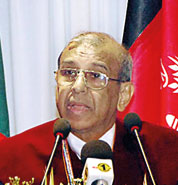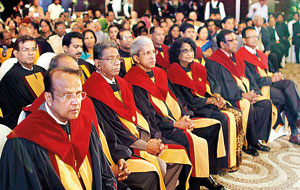It is a boost for women’s health and many are the issues of importance to this group who form a majority not only in Sri Lanka but also in South Asia being discussed at Colombo this weekend.
Horizontal integration of all spheres of women’s health is the need of the hour, Prof. Harshalal Seneviratne, the Dean of the Colombo Medical Faculty and newly-inducted President of the South Asia Federation of Obstetrics and Gynaecology (SAFOG) stressed on Friday night to a large and distinguished gathering.
 |
| The newly-inducted President of SAFOG, Prof. Harshalal Seneviratne announcing his vision |
Around 400 delegates mainly Obstetricians and Gynaecologists not only from Bangladesh, India, Nepal, Pakistan, Afghanistan, Bhutan, Maldives and Myanmar but also from all over Sri Lanka had gathered on Friday for the inauguration of the joint 8th SAFOG Conference and the 44th Annual Scientific Sessions of the Sri Lanka College of Obstetricians and Gynaecologists (SLCOG).
The Chief Guest at the inauguration was Health Minister Maithripala Sirisena while the Guests of Honour were Dr. Monirul Islam of SEARO, World Health Organization and Emeritus Professor M. Sivasuriya, Chancellor of the University of Jaffna.
The two-day conference and sessions on the theme ‘New Horizons for Reproductive Health’ will discuss many important issues with some pre-congress workshops focusing on many a hush-hush topic in the region such as sexual medicine and gender-based violence.
Health services for women should cut across all periods of their life, focusing from womb to tomb or birth to death, explained Prof. Seneviratne, detailing the different phases in a woman’s life as birth, childhood, adolescence, reproductive period and finally post re-productive period. Health services, without looking in isolation at the different phases must address them as a whole and include infertility, cancers as well as sexually transmitted diseases, he said. “Sri Lanka provides such a service without a user fee.”
Pointing out that South Asia bore the burden of around 190,000 (35%) maternal deaths of the 536,000 that occurred globally, SLCOG President Dr. Ananda Ranatunga said the conference provided an ideal occasion not only to discuss problems and solutions regarding women’s health but also share experiences.
“We are very proud of the high standard of maternity and gynaecological services provided in Sri Lanka,” he said, adding, “We need to improve them further.”
Professional development to update the service providers with new knowledge will definitely improve the quality of care provided, he said.
The Sunday Times and the Daily Mirror are the print media sponsors of the 8th SAFOG Conference and the 44th Annual Scientific Sessions of the SLCOG.
(Please see the Sunday Times MediScene magazine which is dedicated to the sessions. The contributing Obstetricians and Gynaecologists deal with a range of issues which are of importance to women.)
Beginnings of SAFOG
It was in Colombo back in 1995 that India, Pakistan, Sri Lanka, Bangladesh and Nepal “conceived” the formation of the South Asia Federation of Obstetrics and Gynaecology as they all had many common features historically, culturally, economically and politically.
Drafting the Constitution in Colombo, the inaugural congress was held in Lahore, Pakistan, in November 1996, with the Maldives and Bhutan joining in.
Now as the 8th conference comes around, its outgoing President Prof. Abdul Bayes Bhuiyan of Bangladesh states that SAFOG has matured to be an organization enjoying prestige and dignity in the region.
 |
| Eminent Obstetricians and Gynaecologists at the inauguration.
Pix by Sanka Vidanagama |
“In spite of geographical distances and barriers we could achieve much by the active participation and dedication of member societies while linking with other federations in a unique manner so as to foster a global network of collaborations,” he says, explaining, “The South Asia region consists of people who are disadvantaged in terms of health and nutrition. Traditionally SAFOG conferences have generated new vision and philosophy for the improvement of the reproductive health of the vast majority of people in the region.”
Women, particularly those who are pregnant, and neonates (newborns) are our target population in whom SAFOG aims to bring about changes in the status of health, he adds.
Sri Lanka College of Obstetricians and Gynaecologists
The beginnings were humble and simple. Most probably it was over tea and cake, at St. Bryce Dale in the heart of Cinnamon Gardens, the home of Dr. (Mrs.) May Ratnayake, that the inaugural meeting was held on November 19, 1953.
It was here that a committee was elected to frame a constitution for the first association of obstetricians and gynaecologists called the Ceylon Obstetrics and Gynaecological Association.
The core group at that time, more than half a century ago, who set the wheels in motion included the eminent Sir Nicholas Attygalle, with LMS (Cey), MRCS, LRCP, DLO, FRCS, FRCOG behind his name, and Dr. (Mrs.) Ratnayake.
The association clearly depicted its status when in the editorial of the first journal in 1954, it stated thus: “The Association of Obstetrics and Gynaecology is not a trade union, nor does it exist for the main purpose of fighting for the rights and privileges of its members. “The only fight that figures in our aims is that against maternal and infant mortality.”
The path the association was to take being clearly paved, it later evolved into the Association of Obstetrics and Gynaecology of Ceylon, the inaugural meeting being held on December 15, 1967 at the De Soysa Maternity Hospital lecture theatre with Sir Nicholas as patron and Prof. D.A. Ranasinghe as President. Interestingly, the initial subscription for members was Rs. 15 per annum.
Elevation to the status of a college -- the Ceylon College of Obstetricians and Gynaecologists came in May 1970 and finally with the Republican Constitution being introduced to the country, it became the Sri Lanka College of Obstetricians and Gynaecologists.
A major achievement in the very early days of the 1950s was the rectification of the practice of separation of gynaecology from obstetrics especially in the hospitals in Colombo. “In contrast to the accepted practice in the rest of the world, in Colombo up to 1954, obstetricians still continued to practise only in midwifery in the two women’s hospitals – De Soysa Maternity Hospital (DMH) and Castle Street Hospital for Women (CSHW). Gynaecology in Colombo was practised at separate institutions viz – The Lady Havelock Hospital (LHH) and also at the General Hospital Colombo (GHC). This was subsequently rectified with the closure of the LHH in 1954 and the introduction of gynaecology beds at DMH and CSHW,” according to the ‘History of the SLCOG 1953-2003’.
Fifty-eight years on, the road travelled by the SLCOG is long with many a milestone. The foundation on which that first group built up this institution has not weakened.
For the only speciality in medicine that looks after two, mother and unborn baby, and not one patient the focus is crystal clear – it still is to prevent the deaths of mothers and children. With the introduction of the concept of reproductive health, the significance of the father and family has also emerged.
While currently in Sri Lanka there are around 360,000 births per year, the maternal death rate is around 30-40 per 100,000 deliveries, comparable to developed countries and considered one of the safest maternity services in South Asia. The SLCOG’s vision is to improve reproductive health further. |



